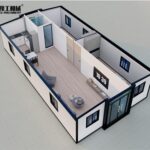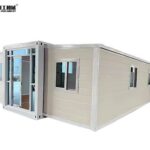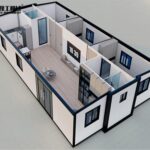Expandable container house for sale is a modular structure built from repurposed shipping containers, designed to expand horizontally or vertically using hydraulic or mechanical systems. Unlike traditional shipping container homes, which are static and limited in space, expandable models offer adjustable living areas. When collapsed, they resemble standard shipping containers, making them easy to transport. Once deployed, they can triple in size, creating spacious interiors without sacrificing portability.
Advantages Of Expandable Container House
1 Cost-Effectiveness
Traditional construction projects often involve high labor and material costs. In contrast, expandable container house for sale is prefabricated in controlled factory environments, reducing waste and speeding up production.
2 Rapid Deployment
Time-sensitive projects such as emergency housing or temporary offices benefit from the quick installation of these units. Most models can be assembled within days, minimizing disruption to schedules
3 Eco-Friendly Design
Repurposing shipping containers reduces the environmental impact of manufacturing new materials. Many expandable container houses incorporate solar panels, rainwater harvesting systems, and energy-efficient appliances, further promoting sustainability.
Applications Of Expandable Container House for Sale
Residential Use
Families seeking affordable housing or vacation homes increasingly opt for these units. Their compact footprint is ideal for urban areas, while expanded configurations provide ample space for rural retreats.
Commercial Spaces
Businesses use expandable containers as pop-up shops, offices, or hospitality venues like cafes and guesthouses. The mobility allows entrepreneurs to test markets without long-term leases.
Emergency Housing
Governments and NGOs deploy these structures in disaster-stricken regions to provide swift shelter for displaced communities
Installation And Maintenance Tips
While an expandable container house for sale is designed for easy setup, proper planning ensures optimal results
Site Preparation
Clear the land level the ground and lay a foundation, such as concrete piers or a gravel bed to prevent moisture damage
Utility Connections
Plan for electrical, plumbing, and HVAC systems in advance. Concealed wiring and pre-installed pipelines simplify the process
Regular Maintenance
Inspect the structure annually for rust leaks or insulation issues. Repaint surfaces as needed and clean the drainage systems to prevent blockages.




